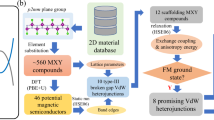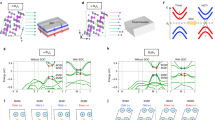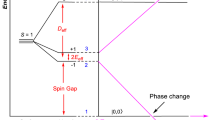Abstract
Recent discovery of spin-polarized single-Dirac-cone1,2,3,4,5,6 insulators7,8,9,10,11,12, whose variants can host magnetism13 and superconductivity14, has generated widespread research activity in condensed-matter and materials-physics communities. Some of the most interesting topological phenomena, however, require topological insulators to be placed in multiply connected, highly constrained geometries with magnets and superconductors15,16,17,18,19,20,21, all of which thus require a large number of functional variants with materials design flexibility as well as electronic, magnetic and superconducting tunability. Given the optimum materials, topological properties open up new vistas in spintronics, quantum computing and fundamental physics. We have extended the search for topological insulators from the binary Bi-based series2,3,4,5,6 to the ternary thermoelectric Heusler compounds22,23,24,25. Here we show that, although a large majority of the well-known Heuslers such as TiNiSn and LuNiBi are rather topologically trivial, the distorted LnPtSb-type (such as LnPtBi or LnPdBi, Ln=fn lanthanides) compounds belonging to the half-Heusler subclass harbour Z2=−1 topological insulator parent states, where Z2 is the band purity product index. Our results suggest that half-Heuslers provide a new platform for deriving a host of topologically exotic compounds and their nanoscale or thin-film device versions through the inherent flexibility of their lattice parameter, spin–orbit strength and magnetic moment tunability paving the way for the realization of multifunctional topological devices.
This is a preview of subscription content, access via your institution
Access options
Subscribe to this journal
Receive 12 print issues and online access
$259.00 per year
only $21.58 per issue
Buy this article
- Purchase on Springer Link
- Instant access to full article PDF
Prices may be subject to local taxes which are calculated during checkout




Similar content being viewed by others
References
Moore, J. E. The birth of topological insulators. Nature 464, 194–198 (2010).
Xia, Y. et al. Observation of a large-gap topological-insulator class with a single Dirac cone on the surface. Nature Phys. 5, 398–402 (2009).
Hsieh, D. et al. A tunable topological insulator in the spin helical Dirac transport regime. Nature 460, 1101–1105 (2009).
Zhang, H. et al. Topological insulators in Bi2Se3, Bi2Te3 and Sb2Te3 with a single Dirac cone on the surface. Nature Phys. 5, 438–442 (2009).
Chen, Y. L. et al. Realization of a three dimensional topological insulator Bi2Te3 . Science 325, 178–181 (2009).
Hsieh, D. et al. Observation of time-reversal-protected single-Dirac-cone spin-polarized topological-insulator states in Bi2Te3 and Sb2Te3 . Phys. Rev. Lett. 103, 146401 (2009).
Fu, L. & Kane, C. L. Topological insulators with inversion symmetry. Phys. Rev. B 76, 045302 (2007).
Moore, J. E. & Balents, L. Topological invariants of time-reversal-invariant band structures. Phys. Rev. B 75, 121306 (2007).
Roy, R. Topological phases and the quantum spin Hall effect in three dimensions. Phys. Rev. B 79, 195322 (2009).
Qi, X-L., Hughes, T. L. & Zhang, S-C. Topological field theory of time-reversal invariant insulators. Phys. Rev. B 78, 195424 (2008).
Hsieh, D. et al. A topological Dirac insulator in a quantum spin Hall phase. Nature 452, 970–974 (2008).
Hsieh, D. et al. Observation of unconventional quantum spin textures in topological tnsulators. Science 323, 919–922 (2009).
Hor, Y. S. et al. The development of ferromagnetism in the doped topological insulator Bi2−xMnxTe3. Preprint at http://arxiv.org/abs/1001.4834 (2010).
Wray, L. et al. Observation of unconventional band topology in a superconducting doped topological insulator Cux−Bi2Se3. Preprint at http://arxiv.org/abs/0912.3341 (2009).
Fu, L. & Kane, C. L. Probing neutral Majorana fermion edge modes with charge transport. Phys. Rev. Lett. 102, 216403 (2009).
Qi, X-L. et al. Inducing a magnetic monopole with topological surface states. Science 323, 1184–1187 (2009).
Essin, A., Moore, J. E. & Vanderbilt, D. Magnetoelectric polarizability and axion electrodynamics in crystalline insulators. Phys. Rev. Lett. 102, 146805 (2009).
Dzero, M. et al. Topological Kondo insulator. Phys. Rev. Lett. 104, 106408 (2010).
Linder, J. et al. Unconventional superconductivity on a topological insulator. Phys. Rev. Lett. 104, 067001 (2010).
Ran, Y. et al. Composite fermions and quantum Hall stripes on the topological insulator surface. Preprint at http://arxiv.org/abs/1003.0901 (2010).
Bonderson, P. et al. A blueprint for a topologically fault-tolerant quantum computer. Preprint at http://arxiv.org/abs/1003.2856 (2010).
Tobola, J. & Pierre, J. Electronic phase diagram of the XTZ (X=Fe, Co, Ni; T=Ti, V, Zr, Nb, Mn; Z=Sn, Sb) semi-Heusler compounds. J. Alloys Compounds 296, 243–254 (2000).
Canfield, P. C. et al. Magnetism and heavy fermion-like behaviour in the LnBiPt series. J. Appl. Phys. 70, 5800–5802 (1991).
Mastronardi, K. et al. Antimonides with the half-Heusler structure: New thermoelectric materials. Appl. Phys. Lett. 74, 1415–1417 (1999).
Kandpal, H. C., Felser, C. & Seshadri, R. Covalent bonding and the nature of band gaps in some half-Heusler compounds. J. Phys. D 39, 776–785 (2006).
Wyckoff, R. W. G. Crystal Structures (Krieger, 1986).
Dornhaus, R., Nimtz, G. & Schlict, B. Narrow Gap Semiconductors: Springer Tracts in Modern Physics 98 (Springer, 1983).
Bernevig, B. A., Hughes, T. L. & Zhang, S-C. Quantum spin Hall effect and topological phase transition in HgTe quantum wells. Science 314, 1757–1761 (2006).
Blaha, P., Schwarz, K., Madsen, G. K. H., Kvasnicka, D. & Luitz, J. WIEN2k, An Augmented Plane Wave Plus Local Orbitals Program for Calculating Crystal Properties. (Techn. Univ. Wien, 2001).
Perdew, J. P., Burke, K. & Ernzerhof, M. Generalized gradient approximation made simple. Phys. Rev. Lett. 77, 3865–3868 (1996).
Acknowledgements
M.Z.H. acknowledges discussions with B. A. Bernevig and C. L. Kane and support from the US DOE and an A. P. Sloan Research Fellowship. H.L. acknowledges visiting scholar support from Princeton University. A.B. acknowledges support from the DOE. R.J.C. acknowledges discussions and long-standing collaborations with C. Felser and T. Kilmczuk on thermoelectric and superconducting Heusler phases and with Y. S. Hor on ternary topological materials, and support from NSF-MRSEC.
Author information
Authors and Affiliations
Contributions
M.Z.H. and R.J.C. conceived the search for multifunctional ternary topological insulators. S.J. and R.J.C. grew the ternary materials; S.J. and S.X. characterized the samples for lattice constants and checked for time-reversal invariance. H.L. carried out the calculations with assistance from M.Z.H.; L.A.W. and Y.X. contributed ideas and to writing the paper; R.J.C., A.B. and M.Z.H. supervised the overall project.
Corresponding author
Ethics declarations
Competing interests
The authors declare no competing financial interests.
Supplementary information
Rights and permissions
About this article
Cite this article
Lin, H., Wray, L., Xia, Y. et al. Half-Heusler ternary compounds as new multifunctional experimental platforms for topological quantum phenomena. Nature Mater 9, 546–549 (2010). https://doi.org/10.1038/nmat2771
Received:
Accepted:
Published:
Issue Date:
DOI: https://doi.org/10.1038/nmat2771
This article is cited by
-
Exploring the physical properties of Co2MnSi full Heusler alloy: a first principles study
Optical and Quantum Electronics (2024)
-
Colossal negative magnetoresistance in field-induced Weyl semimetal of magnetic half-Heusler compound
Nature Communications (2023)
-
First-principle investigation of LiSrX (X=P and As) half-Heusler semiconductor compounds
Indian Journal of Physics (2023)
-
Structural, half-metallic, electronic, magnetic and pressure-induced elastic changes of PdVSi, PdVGe, PdVSn, and PdVSb alloys
Journal of Materials Science (2023)
-
Experimental studies of Cr2NiAl half-metallic inverse Heusler compound for spintronic applications
Journal of Materials Science: Materials in Electronics (2023)



